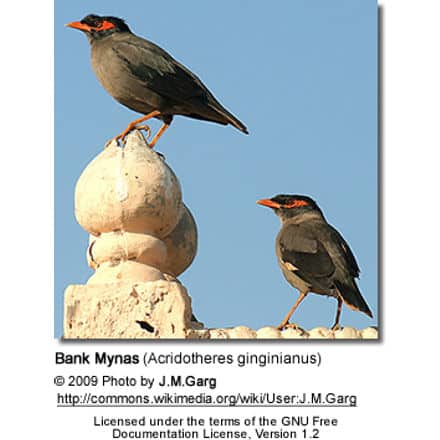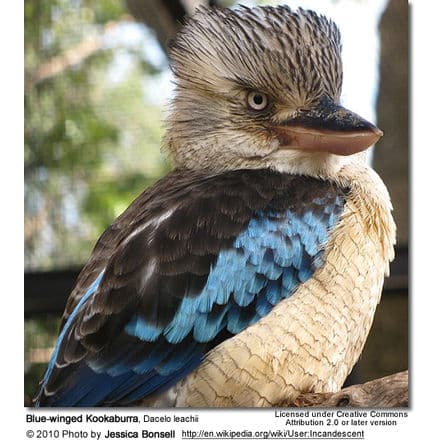Bank Myna
Bank Myna (Acridotheres ginginianus) is a myna or starling occurring in South Asia. It ranges from Sind, Pakistan to Bangladesh. It is similar in colouration and shares its range with the Common Myna, but is slightly smaller.
Distribution
The Bank Myna is found in Sind, Pakistan, on the West, covers the greater part of northern India, east to Bangladesh, southwards generally to latitudes of Mumbai, Maharashtra ie 19° North and Balasore, Orissa i.e. 21° North.
The Bank Myna is absent from the drier regions in Rajasthan. It has a patchy distribution but is most common in major river valleys.
Mostly resident, the bank myna shows regular seasonal local movements in some areas. Individual stragglers have been documented from as far as Kandahar, Afghanistan, and Chennai, India. The record from Chennai may have been an escaped cage bird.
Local Names
The local names for the Mynah are:
- Ganga myna (Hindi);
- Gang salik (Bengali);
- Barad myna (Bihar);
- Bardi myna (Nepal);
- Lali (Sind);
- Daryla Myna (Uttar Pradesh).
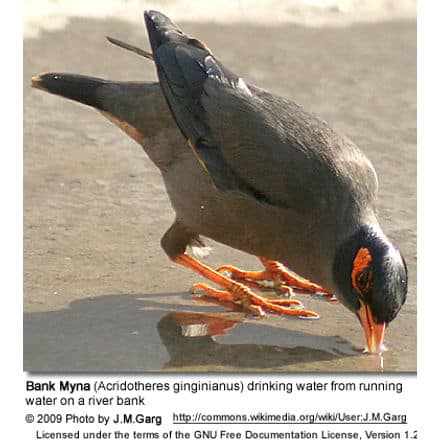
Habitat
The bank myna is found amongst rocks, in open country and around human habitations, often near tea stalls and markets, etc. Railway stations are particularly favoured. Commonly found in riverside habitats, the Hindi and Bengali names of the birds refer to this aspect.
Description
A stocky, bluish-grey mynah with a deep orange bill and eye patches. Noticeably smaller and greyer than the Common Mynah. Other differences include:
- The colouration is pale bluish-grey instead of brown. Also, the black crown has a sharp boundary in the Bank Myna as opposed to a gradation in the case of Common Myna.
- The naked skin’s round eyes are brick-red instead of yellow.
- The wing patch and tips of tail feathers are pinkish buff instead of white.
Sexes of the Bank Myna are alike. The juveniles are paler and browner.
Bank Mynas are gregarious and can be found in flocks even during the breeding season. These birds are usually very tame and confident. Often seen on railway stations, sauntering along platforms, in and out of the feet and baggage of passengers, picking up bits of food, they have been noticed in markets, such as Old Delhi, surreptitiously hopping onto vendors’ handcarts to steal scraps.
Bank Mynas also haunt municipal refuse dumps for scraps and tidbits and sometimes attend to grazing cattle for ticks or insects.
The voice is somewhat softer than that of the Common Myna.
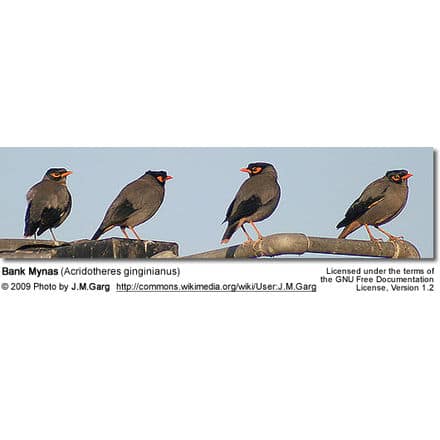
Food
Bank Mynas eat fruit, grain, and insects. They can be very destructive to ripening crops of Sorghum (jowar). On the other hand, stomach contents of Bank Mynas in Bihar have recorded among other things, the larvae of the moth Ophiusa melicerte, which is highly injurious to castors.
Nesting
Bank Mynas have a nesting season from April to August, with most birds nesting from May to June.
The nest is a pad of grass and rubbish, stuffed in the widened chamber at the end of a horizontal earth tunnel. These tunnels may be drilled in steep earth banks of rivers, sides of disused brick kilns, earthen wells, or even in masonry. The nests have been known to include bits of sloughed-off snake skin.
Bank Mynas often breeds in colonies along with the Common Myna. Records of fifty or more pairs in a single colony are known.
The Bank Myna usually lays 3 to 5 eggs in a clutch. These eggs are a glossy pale blue.
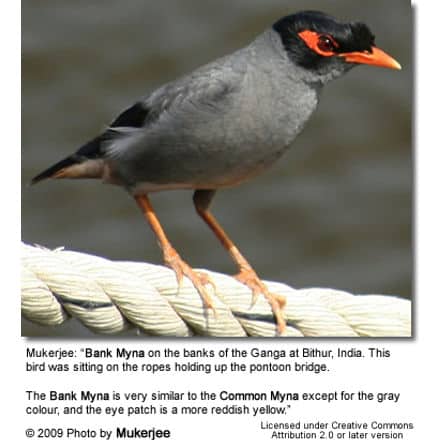
References
- BirdLife International (2004). 2006 IUCN Red List of Threatened Species. IUCN 2006. Retrieved on 2007-04-21. Evaluations (history: 1988 / 1994 / 2000, all LC). There is evidence of a population increase (Feare et al. 1998).
- Ali, Salim; Sidney Dillon Ripley (1986/2001). Handbook of the Birds of India and Pakistan, 2nd ed.,10 vols. Oxford University Press. Bird number 1008, vol. 5, p.181-183.
- Grewal, Bikram; Bill Harvey and Otto Pfister (2002). A photographic guide to birds of India. Periplus editions.
- Ali, Salim; J C Daniel (1983). The Book of Indian Birds, Twelfth Centenary edition. Bombay Natural History Society/Oxford University Press.

